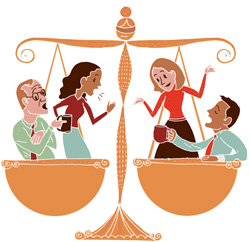Supreme Court Year in Review

Dahlia and Walter,
Before we close out this year's Breakfast Table discussion, I wanted to respond to Walter's post about all the legal issues being discussed outside the Supreme Court—whether it is testimony about the War Powers Act on the Hill or legal changes at the state level—and Dahlia's question about next term.
As to Walter's point that a Supreme Court term that lacked any signature cases stands in stark contrast with all the intense legal discussions going on outside the courts, I would only add that somewhere, as he prepares for his summer vacation, the chief justice is smiling. The term just completed was Chief Justice John Robert's sixth on the court. Given how long the chief is likely to serve, on most issues it is too early to say anything terribly definitive about the Roberts Court. From the perspective of history, we are still looking at the early returns. But the one trend that emerges reasonably clearly is that, outside the First Amendment context, the Roberts Court prefers narrow, as-applied challenges to broad, facial attacks on statutes or policies. With some notable exceptions, like Massachusetts v. EPA, the Roberts Court has also limited standing doctrines and raised pleading standards so as to limit judicial controversies to concrete, well-defined disputes. In other words, the fact that some of the pressing legal disputes of the day are being debated outside the courts is no accident.
That said, to answer Dahlia's question, next term may look very different in this regard, as a number of high-profile issues seemed headed to the court. Walter may have more to say on which issues are likely to arrive when, but at a more general level, I think two things are likely to be true. First, one or more of the big issues will arrive next term, such that a year from now people may be lamenting the court's decisions but not that it was a relatively sleepy term. Second, I would bet against all the cases arriving at once. It certainly could happen, but litigation has its own rhythms, and cases can take unexpected turns. Take the Proposition 8 challenge, for example. When that case was filed in federal court, few would have foreseen a trip to the California Supreme Court on a standing question.
And to tie these two threads together, the more courts insist on turning square corners and ensuring that only concrete disputes are litigated, the more likely it is for cases to get off the fast track to Supreme Court resolution. But one way or another—in one term or another—some big cases are headed to the court and destined to enliven the breakfast table.
Paul